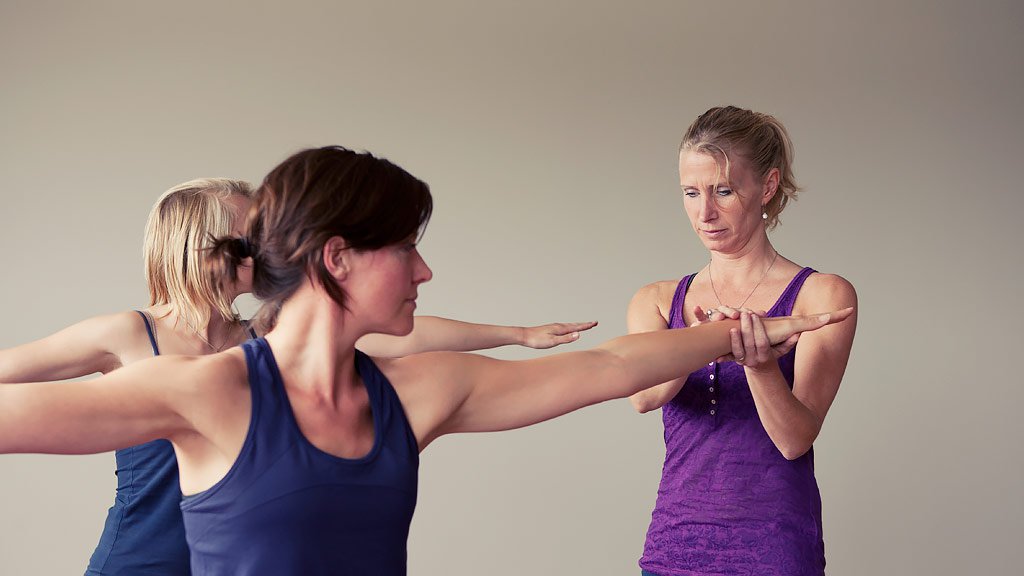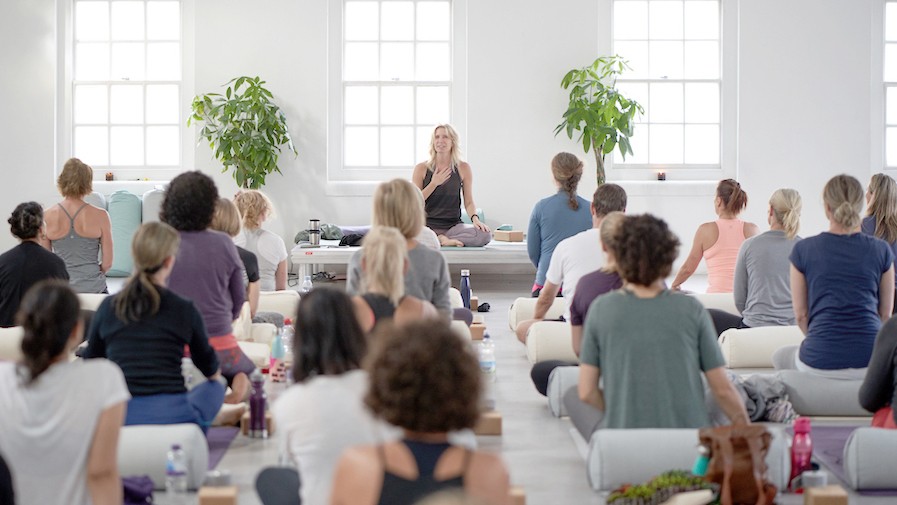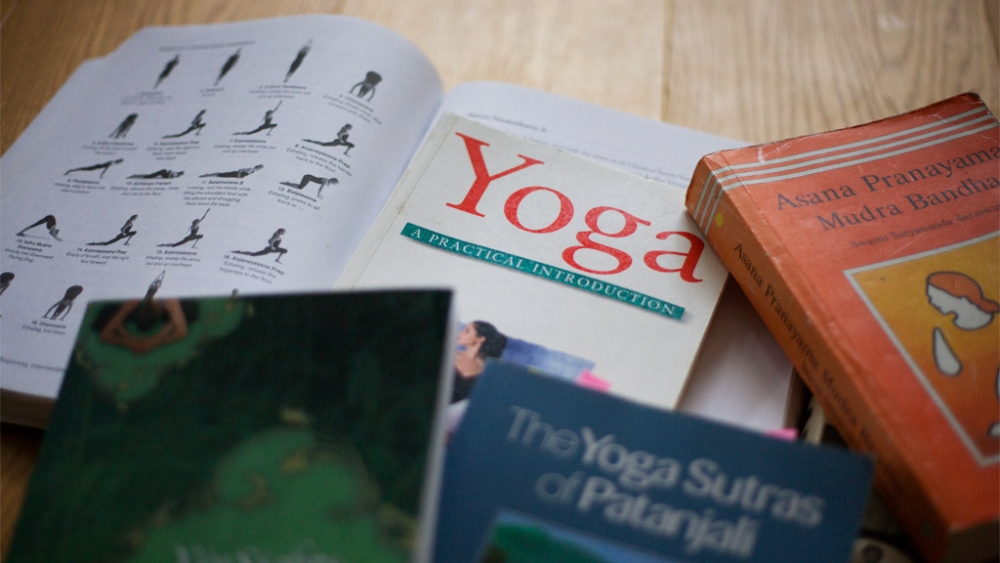1. Do a little research
It’s worth doing a bit of background research about the teacher and their style of yoga before joining your first yoga class. If you can, have a chat with the teacher beforehand so you can ask them any questions. This gives them chance to understand a little about your reasons for doing yoga too – it may be that you want to get more flexible, use yoga to compliment another sport that you enjoy, or that you are looking for a bit more balance in your life.
- Hatha, Vinyasa, Yin, Iyengar…? If you’re unsure what style of yoga will suit you best, read our yoga style guide.
2. Get to class early
Try and get to class at least ten minutes early. Your teacher will probably want to know if you’ve done yoga before or check if you have any injuries they need to be aware of. Also, if you arrive early enough you can choose your mat space (which for beginners is usually at the back of the room!)
- Tip: You may feel as if everyone is looking at you: they’re not. Yoga is an internal practice and many people become so tuned into their own experience they may not even recall who was there after class! Also, remember, even if you have positioned yourself ‘safely’ at the back of the room, some of the time people will be in downward dog gazing through their legs, so you won’t actually be completely invisible to the naked eye (even if you’d prefer to be!)
3. The human touch?

Your teacher might ask whether you’re happy to be adjusted during the class. It’s lovely to receive hands-on adjustments as it can help you to gain better alignment or move you into a deeper expression of a pose. However, do tell your teacher if you prefer not to be touched. You shouldn’t have to give any reasons or say any more than “I’m ok thanks”. Similarly, if a teacher is halfway through adjusting you and it feels too strong, speak up!
- Tip: Don’t feel discouraged if the teacher adjusts you – it’s not a sign that you’re doing it ‘wrong’ – it’s more likely that they are simply trying to help you find more ‘ease’ in the pose.
4. What to wear
If you’ve never done yoga before (and you’re aware of social media!) you may be forgiven for thinking yogis are ‘super-thin fashionistas’. Most are not! Yoga is for everyone and it’s more important that you feel comfortable in what you’re wearing than you’re wearing the latest yoga pants.
Wear layers on your top half so you can shed them if you build up too much heat (then put them on again in Savasana). Wear something that’s not too loose to prevent your top riding up or suffocating you during downward dog. High-waisted leggings or loose trousers are a good idea too – it’s better that you’re focusing on what the teacher is saying rather than worrying about whether you’re flashing your knickers.
Men are more limited in their choice of yoga clothes but tracksuit bottoms may be too thick or the material too slippery (Tree pose is challenging enough without your clothes proving even more of a hindrance!). Try stretchy shorts or even Thai Fisherman’s pants (great for rolling up).
- Tip: One of the great things about doing online yoga is you can wear whatever you like! Read our Pros and Cons of Online Yoga article for more! Also read our Yoga pants review where we put some best selling brands to the test!
5. Socks off
Yoga is practised with bare feet. At the start of the class you might want to keep your socks on if it’s cold but your teacher will advise you when it’s time to take them off. You can buy special grip yoga socks if you don’t like going barefoot.
- Tip: Try not to walk on someone else’s yoga mat – it may sound trite but due to the transformative experiences people have during yoga, some regard their mat not just as a piece of rubber but an extension of themselves! Some may also consider it as an invasion of their personal space or simply just be irritated that you stepped on something that belongs to them with your “dirty feet”!
6. What to eat before yoga
It’s best not to do a class on a full stomach – you (or those around you) may pay the price! On the other hand, it’s also not a good idea to practice on a completely empty stomach either – most people find their first yoga class more physically challenging than they expected. Perhaps eat a small snack beforehand – a banana, a few dates, a handful of nuts or a yoghurt, for example – so you don’t feel light-headed.
- Read: Try these easy-to-make Post Yoga Bites for afterwards.
7. Blocks and props
Equipment – usually your teacher (or yoga studio) will provide equipment – mats, belts, blocks, blankets – but it’s worth checking if you need to bring them with you. If you don’t have any yoga props, here are are few things you can use in their place.
- Tip: Check out our Best Yoga Mat review here.
8. Eka Pada what?
Your teacher may refer to the yoga poses in their Sanskrit names (most teachers use the English versions too) so you’re likely to be unfamiliar with some of the language they use at first. Don’t worry, you’ll begin to recognise them in time.
- Tip: read our Yoga Lingo for Beginners article which lists the most common terms you might hear during yoga.
9. Your space
You may need to re-evaluate your personal space. I’ve been to classes where there is literally 5 cms between my mat and the next person’s. It might feel strange at first but you’ll soon get used to it. Yes, yoga is an internal practice but it’s sometimes a little more difficult to tune into this concept if you have someone’s big toe hovering just above your face!
10. Your edge
As a beginner, it can be difficult to distinguish between pain and discomfort. Pain is hot and sharp, like sudden a pinching sensation. You should not feel pain during yoga. Discomfort is more like a nagging sensation and may change if, for example, you breathe into it. The golden rule of thumb is – you are your best teacher. You know your own body better than anyone else and if something feels wrong, it probably is.
The golden rule of thumb is – you are your best teacher. You know your own body better than anyone else and if something feels wrong, it probably is.
- EkhartYoga members: Learn how to feel into your natural boundaries with this 30 minute, all level class with Sandra Carson – Listen and regulate practice.
11. To Ohm or not to Ohm…
Many yoga classes start by chanting Om – but if it’s a longer chant it will usually be a call and response. If you don’t want to join in, don’t, but chanting is a lovely way of uniting the energy of the group and you might actually enjoy it! Many classes close with the teacher pressing their palms together at their heart bowing their head and uttering the word, ‘Namaste’ – this gesture roughly means ‘the light within me bows to the light within you’.
- Read – Learn more about why we chant Om and what it means.
12. Don’t forget to breathe!
Learning to connect with your breath is one of the most important things you’ll learn in yoga and many teachers incorporate a breathing practice (Pranayama) into their class. They’ll generally give instructions but the most important thing is that you just keep breathing! It might feel a little confusing at first – you might feel as if you’re breathing out when you’re supposed to be breathing in and vice versa! – but again, don’t worry: practise and all is coming!
- Read: Learn more about the different types of breathing techniques and what their benefits are.
13. Emotion
During yoga we learn to become present in our body, and this has the effect of making our subconscious mind begin to feel safe, so the body will begin to relax. Physical tension will dissipate and we may also experience an emotional release as a result of that.
Most of us at some point have experienced strong emotion during yoga – whether it’s tears, frustration, vulnerability, fear, sadness or joy – emotional release is totally normal. Our ‘lesson’ is not to judge it…just to let it be exactly as it is.
- Read: Yoga and emotions – a positive sign!
14. Leave your ego at the door
Remember that yoga is not a competitive sport so leave your self-criticism and comparisons behind. Similarly don’t refuse the aid of props (blocks, belts, blankets etc) just because it makes you ‘look like a beginner’. Using props in a yoga class can make the poses more comfortable (for beginners and experienced yogis alike), give you more space in the pose and help with your alignment.
Similarly, if you need to rest at any point during the class, do so! One of the most important tenets of yoga is ‘Ahimsa’ – which means ‘Non-violence’ or ‘non-harming’. When we act with ‘Ahimsa’ in mind, this means, among other things, not physically harming others or ourselves – so be kind to yourself.
- Read: Yoga and the ego
15. Don’t skip Savasana
Savasana – the relaxation part of the class – can be one of the most challenging parts of the class for beginners and experienced yogis alike but it is also one of the most essential. For years, I used to creep out of the door before Savasana because I “didn’t have time for lying around”.
Savasana is where we fully absorb the benefits of the postures, it can act as a ‘reset’ button, calming the central nervous system and bringing the breath back to normal. It’s the part of the practice where we can truly allow ourselves to simply Be.
- Read: Why Savasana may be the most important pose in your yoga practice.
16. The beginner’s mind
Much has been written about yoga and the beginner’s mind – the idea being that in our quest to progress to more complicated poses, we lose the essence of what yoga is really about. Shoshin – the beginner’s mind – is a concept in Zen Buddhism which means to approach something with openness, eagerness and a lack of preconceptions – even when studying something at an advanced level.
Remember that you can’t be ‘bad’ at yoga – there will always be someone who is stronger and more flexible than you; it’s the approach with which you practise that is key.
Remember that you can’t be ‘bad’ at yoga – there will always be someone who is stronger and more flexible than you; it’s the approach with which you practise that is key.
Patience, openness, the commitment to show up on your mat, respecting your body’s boundaries, learning to connect with sensation and your breath and the willingness to be in the present moment are all far more important than whether you can balance in tree pose for 5 minutes. So rather than being frustrated at being a beginner, enjoy the experience – you never know, if you keep practising, you may not be a beginner for very long!


